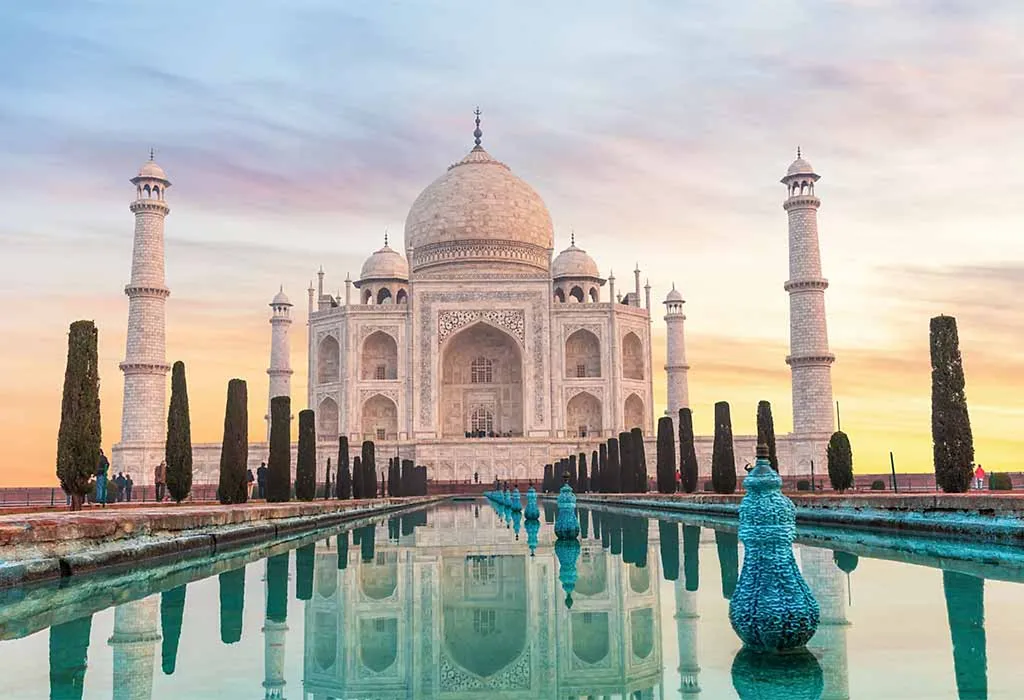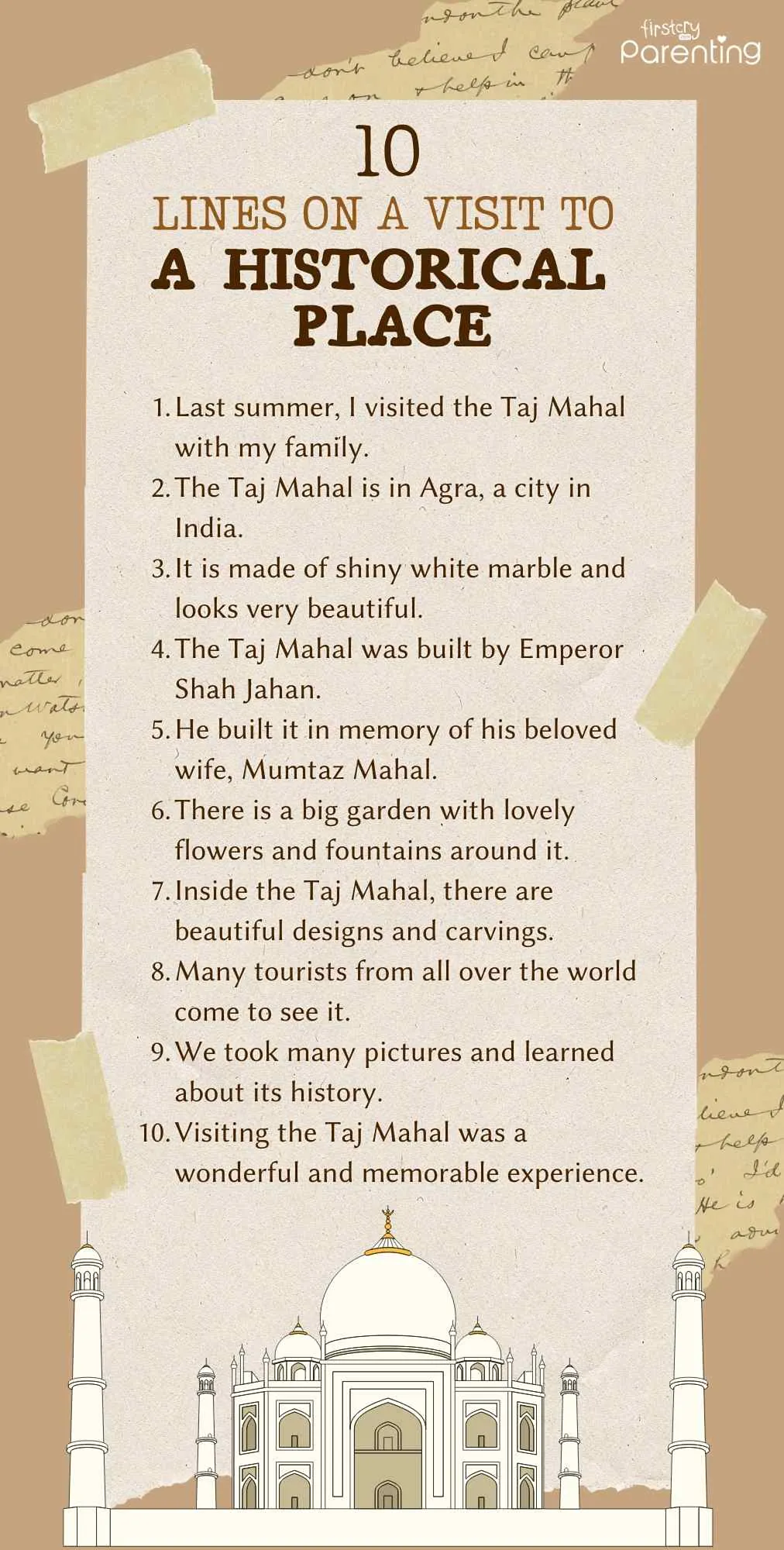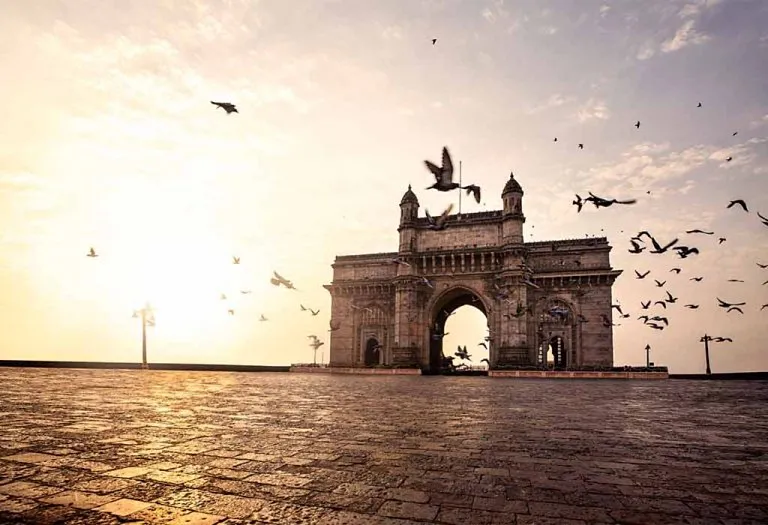A Visit To A Historical Place Essay – 10 Lines, Short and Long Essay
- Key Points to Remember When Writing an Essay on a Visit to a Historical Place
- 10 Lines on a Visit to a Historical Place
- Paragraph on a Visit to a Historical Place
- Short Essay on a Visit to a Historical Place
- Long Essay on a Visit to a Historical Place
- What Are Some Best Historical Places to Visit in India?
- What Will Your Child Learn From a Visit to a Historical Places Essay?
- FAQs
- Infographic – 10 Lines on a Visit to a Historical Place Essay
Writing is a way of expressing one’s thoughts and experiences, and an essay is one such format. Essay writing is an integral part of the academic curriculum, particularly for young learners. One common topic that many students are asked to write about is a visit to a historical place. This provides an opportunity to develop their descriptive skills and broaden their understanding of history and culture. In this article, we will learn how to write an essay on a visit to a historical place, catering to different lengths and complexities. This exercise is an excellent learning tool for kids, and the following guidelines will make the process even more comfortable. The objective here is to enhance essay writing skills, primarily focusing on how to write an essay in English for kids.
Key Points to Remember When Writing an Essay on a Visit to a Historical Place
When writing an essay on a visit to a historical place, remember the following points:
- Describe the historical place you visited.
- Discuss why you chose to visit this place.
- Explain the historical significance of the place.
- Discuss the experience and your feelings during the visit.
- Conclude by explaining what you learned from the visit.
10 Lines on a Visit to a Historical Place
Writing a 10-line essay can be a fun activity, especially when it involves narrating a personal experience. This format is aptly titled 10 lines essay for kids. Here is an example:
- Last summer, I visited the Red Fort in Delhi with my family.
- The Red Fort is a magnificent historical monument built by Emperor Shah Jahan.
- The red sandstone walls of the fort are impressive and fascinating.
- We explored its beautiful gardens, halls, and museum.
- I was excited to see the place where the Indian Independence Day is celebrated every year.
- The intricate architecture of the fort is a testament to the skills of ancient artisans.
- The fort’s museum showcases many historical artefacts.
- Learning about the rich history of the Red Fort was truly enlightening.
- This visit made me appreciate the significance of preserving our historical heritage.
- I will always cherish the experience of visiting the Red Fort.
Paragraph on a Visit to a Historical Place
Writing a short paragraph on a visit to a historical place can be a rewarding exercise. It can help students to condense their thoughts and focus on the most important aspects of their experience. Here’s a brief paragraph on visit to a historical place:
Last summer, I had the opportunity to visit the magnificent Taj Mahal in Agra. The grand white marble structure stood against the clear blue sky, taking my breath away. Its intricate carvings and exquisite architecture were a sight to behold. The serene Yamuna river flowing nearby added to its beauty. The Taj Mahal is not just a monument, but a symbol of love, built by Emperor Shah Jahan for his wife Mumtaz Mahal. This visit made me understand why it is one of the Seven Wonders of the World. I returned home with a deeper appreciation for our historical heritage.
This was a visit to a historical place paragraph that’s short yet impactful.
Short Essay on a Visit to a Historical Place
A short essay provides an opportunity to express thoughts in a bit more detail. Let’s look at a short essay on a visit to a historical place:
Last winter, I had the unique opportunity to visit the historical city of Jaipur, also known as the ‘Pink City’. The city is rich in history and culture, with various historical sites that take you back to the era of kings and queens. The primary purpose of my visit was to see the renowned Amer Fort.
The grandeur of Amer Fort is beyond words. Its vast courtyards, beautiful gardens, intricate carvings, and mirrored halls left me in awe. The Sheesh Mahal, a hall decorated with thousands of mirror tiles, was my favourite. The fort’s architecture is a splendid blend of Hindu and Mughal styles, reflecting the richness of Indian heritage.
My visit to Amer Fort was both fun and educational. It gave me insights into the lives of the royalty of ancient India. This visit strengthened my belief in the importance of preserving our historical monuments for future generations.
Long Essay on a Visit to a Historical Place
Historical places are portals to the past, providing us with glimpses of the rich heritage and culture that shaped our world. These sites hold significant historical, architectural, and cultural value, attracting travellers and history enthusiasts alike. Visiting a historical place allows us to transcend time and immerse ourselves in the narratives of our ancestors. One such memorable experience was my visit to a fascinating historical site with my family, an expedition that left an indelible mark on my heart.
Importance of Historical Places
Historical places hold immense importance in preserving our cultural heritage and educating future generations about their roots. They serve as tangible links to the past, reminding us of the struggles, triumphs, and contributions of our forefathers. These sites also offer insights into the architectural marvels of ancient civilisations, showcasing their engineering prowess and artistic ingenuity. By exploring historical places, we develop a sense of connection to our history, fostering a deeper appreciation for our cultural identity and collective evolution as a society.
A Visit to a Historical Place With My Family
Last summer, my family and I embarked on a memorable journey to explore the wonders of history. Our destination was the captivating historical site of Machu Picchu, nestled amidst the breathtaking Andes Mountains in Peru. Excitement brimmed within us as we set foot on this iconic archaeological marvel, famously known as the “Lost City of the Incas.”
As we approached the ancient citadel, shrouded in mist, I was awestruck by its grandeur and mysterious aura. Our knowledgeable tour guide provided us with intriguing historical facts, transporting us back in time to the Inca civilisation’s heyday. The stories of this once-thriving city, its purpose, and the enigma surrounding its abandonment left us spellbound.
The intricate stonework of Machu Picchu stood as a testament to the ingenuity and architectural expertise of the Inca people. The precision with which the massive stone blocks were fitted together without the use of mortar was awe-inspiring. We marvelled at the ingenious drainage system that allowed rainwater to flow smoothly through the terraces, ensuring the city’s sustainability.
Climbing higher within the site, we reached the majestic Intihuatana stone, often referred to as the “Hitching Post of the Sun.” Believed to have astronomical significance, this stone served as a sundial and played a vital role in religious ceremonies. Standing beside this ancient timekeeping artefact, I felt a profound connection to the Inca’s reverence for celestial events and their deep understanding of the cosmos.
As we explored the Temple of the Sun and the Room of the Three Windows, the intricate carvings and architectural brilliance captivated us. The well-preserved remnants of ancient structures narrated stories of religious practices, ceremonies, and everyday life of the Inca people.
Apart from the historical significance, Machu Picchu’s picturesque location left us breathless. The panoramic views of lush green mountains, terraced fields, and the Urubamba River winding its way through the valley painted a picture of natural splendour.
Our visit to Machu Picchu not only brought us closer to the wonders of history but also strengthened our family bonds. Sharing this awe-inspiring experience with my loved ones created lasting memories that we cherish to this day. As we explored the ancient citadel together, we exchanged thoughts, laughter, and a sense of wonderment, deepening our familial connection.
What Are Some Best Historical Places to Visit in India?

India, a land steeped in history and cultural heritage, is home to a plethora of breathtaking historical sites that showcase the country’s rich past. From ancient temples and majestic forts to intricate palaces and grand monuments, India offers a treasure trove of historical places waiting to be explored. If you are a history enthusiast or someone seeking to immerse yourself in the country’s fascinating past, here are seven of the best historical places to visit in India.
1. Taj Mahal, Agra
The iconic Taj Mahal needs no introduction. Built by Emperor Shah Jahan in memory of his beloved wife Mumtaz Mahal, this architectural marvel is an exquisite example of Mughal craftsmanship. Its mesmerising white marble facade, intricate carvings, and symmetrical gardens make it one of the most recognised and visited monuments in the world, rightfully earning it a place among the Seven Wonders of the World.
2. Red Fort, Delhi
A UNESCO World Heritage Site, the Red Fort in Delhi is a testament to India’s Mughal history. Built by Emperor Shah Jahan, it served as the main residence of the Mughal emperors for nearly 200 years. The fort’s imposing red sandstone walls and intricate architecture, along with the annual Independence Day celebrations held here, make it a must-visit historical site.
3. Ajanta and Ellora Caves, Maharashtra
Located in the state of Maharashtra, the Ajanta and Ellora Caves are a UNESCO World Heritage Site and a testament to India’s ancient rock-cut architecture. The caves consist of beautifully crafted Buddhist, Hindu, and Jain temples and monasteries, adorned with stunning sculptures and frescoes that depict religious and secular themes. These cave complexes are a living testimony to India’s rich cultural and religious diversity.
4. Mehrangarh Fort, Jodhpur
Rising dramatically above the city of Jodhpur, the Mehrangarh Fort is a formidable structure that offers breathtaking views of the Blue City. Built by Rao Jodha, the fort showcases impressive architecture and houses a museum that exhibits artefacts and relics reflecting the history and culture of Rajasthan’s Marwar region.
5. Hampi, Karnataka
Once the capital of the Vijayanagara Empire, Hampi is now a UNESCO World Heritage Site, dotted with stunning ruins and ancient temples. The sprawling site is a testament to the grandeur and architectural brilliance of the Vijayanagara rulers. Hampi’s boulder-strewn landscape and its various monuments, including the Virupaksha Temple and the Vitthala Temple Complex, offer a mesmerising glimpse into India’s medieval history.
6. Khajuraho Temples, Madhya Pradesh
Famous for their intricate and erotic sculptures, the Khajuraho Temples in Madhya Pradesh are a UNESCO World Heritage Site. These stunning temples dedicated to Hindu and Jain deities are a remarkable example of Chandela dynasty architecture. The exquisite carvings, showcasing human emotions, sensuality, and divine aspects, make Khajuraho a unique and culturally significant destination.
7. Fatehpur Sikri, Uttar Pradesh
Founded by Emperor Akbar, Fatehpur Sikri was the capital of the Mughal Empire for a short period. This historical site showcases a blend of various architectural styles, including Islamic, Hindu, and Persian. The impressive structures, such as Buland Darwaza, Panch Mahal, and Jama Masjid, are a testament to Akbar’s vision and artistic taste.
What Will Your Child Learn From a Visit to a Historical Places Essay?
Writing an essay on a visit to a historical place enhances a child’s analytical and descriptive skills. It helps children develop a deeper appreciation for history and cultural heritage. They learn about the significance of these places and understand the importance of their preservation. The exercise also broadens their perspective, making them more aware of the world around them.
FAQs
1. Why is it important to secure historical places?
Securing historical places is crucial to preserve our cultural heritage. These sites provide valuable insights into our past and contribute significantly to our identity as a society. Moreover, historical places attract tourists, promoting local economies and creating job opportunities.
2. Why do people love to visit historical places?
People love visiting historical places as they offer a unique combination of education and exploration. Such visits provide a deeper understanding of history, culture, and architecture. They offer a break from the routine and a chance to connect with the past. Walking around these sites, one can almost feel the pulse of the bygone era, making the experience truly enriching.
3. How can visiting a historical place enhance a student’s learning experience?
Visiting a historical place allows students to connect with history in a tangible way. It brings textbook lessons to life, providing a deeper understanding of historical events, cultures, and architectural advancements. Engaging with the physical remnants of the past can inspire curiosity and foster a greater appreciation for history.
Writing an essay about a visit to a historical place is an enriching exercise for students of all ages. It helps in enhancing their writing skills, expressing their thoughts and feelings, and cultivating an appreciation for history and cultural heritage. This comprehensive guide provides the necessary tools to write engaging and insightful essays of various lengths, from a short 10-line essay to a detailed long essay. With this knowledge, students can now approach essay writing with a more informed and confident mindset.
The importance of historical places can never be overstated. They stand as silent storytellers, echoing the tales of the past, and cultivating in us an appreciation for the cultural, artistic, and architectural feats of our ancestors. Visiting these places is a rewarding experience, and writing about them encourages us to delve deeper into understanding their significance.
These historical monuments are not just edifices of stone and mortar; they are testaments to our heritage, serving as threads that weave the rich tapestry of our history. As we pen down our experiences visiting them, we contribute to their narrative, thereby playing our part in the preservation and celebration of our shared past.
Infographic – 10 Lines on a Visit to a Historical Place Essay

Also Read:
Essay On Journey By Bus
A Visit To A Museum Essay for Kids
Essay on Railway Station for Children
Places to Visit With Family in India
Travelling Screen-free With Kids
Kid Friendly Destinations to Visit in India
Was This Article Helpful?
Parenting is a huge responsibility, for you as a caregiver, but also for us as a parenting content platform. We understand that and take our responsibility of creating credible content seriously. FirstCry Parenting articles are written and published only after extensive research using factually sound references to deliver quality content that is accurate, validated by experts, and completely reliable. To understand how we go about creating content that is credible, read our editorial policy here.























